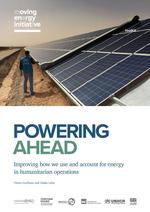Click here to register!
Powering Ahead - Improving How We Use and Account for Energy in Humanitarian Operations - Toolkit
Text by ***** and Glada Lahn
Contents
Improving How We Use and Account for Energy in Humanitarian Operations
This toolkit from the Moving Energy Initiative offers practical guidance for humanitarian agencies that want to make energy cost savings and reduce their carbon and emissions footprint.
Powering Ahead: Improving How We Use and Account for Energy in Humanitarian Operations is a toolkit that is designed to accompany the research paper 'The Costs of Fuelling Humanitarian Aid' which provides insight into energy use in the humanitarian sector and demonstrates the case for change. It reveals the sector’s high dependence on diesel fuel and explores multiple areas in which efficiency improvements, changes in agency practices or investment in renewable energy would generate significant cost savings.
The results of pilots by various humanitarian agencies suggest that the sector could save at least 10 per cent of fuel costs on ground transport, 37 per cent through behaviour change and more efficient technologies and 60 per cent on generation – all using currently available, affordable and proven practices and technology changes. At current prices, this could mean operational savings of over $517 million a year for the humanitarian sector – roughly equal to 5 per cent of UNHCR’s funding gap for 2017.
Five Steps to Improve Energy Use in Humanitarian Operations
The toolkit proposes five steps to improve energy use in humanitarian operations illustrated with real-life examples and practical advice as a starting point and to make progress where change has begun but stalled:
Step 1 – Capture data on energy use
Step 2 – Target quick wins in energy rationalization
Step 3 – Change behaviours and challenge ‘normal’ practice
Step 4 – Invest for long-term change creating virtuous savings cycles
Step 5 – Access external finance and work with private energy services providers
Download the toolkit.
Who Might Use this Toolkit?
This toolkit is a practical guide for humanitarian agencies that want to make energy cost savings and reduce their carbon and emissions footprint. It is part of a series of published outputs examining how energy is used in humanitarian settings. It is designed to accompany our research paper, The Costs of Fuelling Humanitarian Aid, which provides insight into energy use in the humanitarian sector and demonstrates the case for change.
Further Information
- Powering Ahead - Improving How We Use and Account for Energy in Humanitarian Operations. Toolkit by MEI; Authors: Owen Grafham & Glada Lahn (2018)
- The Costs of Fuelling Humanitarian Aid by MEI. Authors: Owen Grafham & Glada Lahn (2018).
- More articles and documents on energy in humanitarian settings, available on energypedia
- Switch to clean energy and save $500 mln, aid agencies told. Reuters, Dec 10, 2018




















